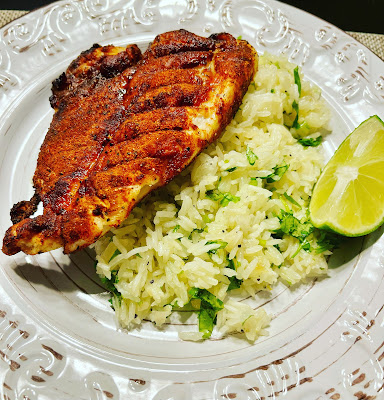One of my very favorite spices for chicken is chipotle chili powder, which has just a tiny bit more spice kick than regular chili powder, without being overwhelmingly hot. This preparation uses chipotle powder almost like flour, creating a savory crust with a hint of heat. As a side, I am pairing the chicken with the cilantro lime rice side. I recommend basmati or jasmine rice for their aromas, but long grain white rice will work just as well. The rice will take longer to prepare, so we will start with that.
Cilantro-Lime Rice
Ingredients:
1 cup basmati or Jasmine (long-grain white) rice
1-1/2 cup water
2 tablespoons olive oil, divided
Juice of 1 lime
1 tsp chicken bouillon
1 tsp onion powder
1 tsp garlic powder
1 bay leaf
1 cup chopped cilantro, not too fine.
salt and pepper to taste
Directions:
Rinse the rice in a strainer under cold running water for a few minutes until the water begins to run clear. In a large sauce pot or deep-sided pan put in the rice, water, the juice of half a lime, 1 teaspoon of olive oil, the garlic and onion powders, bouillon and bay leaf. Stir and bring to a boil. You will have to keep an eye on the rice, boiling it until nearly all the water has evaporated and little steam holes begin to appear on the surface of the rice. This should take about 15 minutes. Once the water is nearly gone, pull the pan from the heat, fluff the rice with a fork and cover it with a tight lid for at least another 15 minutes. Do not peek!
The rice should be very fluffy at the end of this time and not sticky. Pour the rice into a mixing bowl and mix in the juice from the other half of lime, the second teaspoon of olive oil and the chopped cilantro. Taste for seasoning and add salt and pepper as desired. Cover and set aside.
Chipotle Chili-Crusted Chicken Breast
Ingredients:
1 chicken breast, split or butterflied (you may also use chicken tenders)
4 tsp chipotle chili powder (you can use regular chili powder, but it won't have the little spice kick)
4 tsp cumin
2 tsp Mexican oregano (or just oregano)
1 tablespoon olive oil
salt and pepper to taste
1 lime, cut in half
Directions:
Prepare the dry ingredients is a bowl, mix and spread on a plate or shallow baking dish. Preheat the air fryer to 400 degrees for 3 minutes. Make sure the chicken is dry and free of excess water. Pour the olive oil on the chicken and rub on both sides. Season to taste with salt and pepper. Coat the chicken in the spice mixture on both sides, making sure all parts of the split breasts are coated.
Place the chicken in the air fryer and set for 6 minutes at 400 degrees. At the end of the time, open the fryer basket and turn the chicken over. If you have an instant read thermometer check to see if the chicken is 165 degrees. If it's there, reset the fryer for 350 degrees for about 3 or 4 minutes to crisp the second side without overcooking. You may need even less time for the other side.
Mound some rice on a plate and set the chicken up against it. A squeeze of lime on the chicken adds a nice touch to the full flavor of the chipotle chili and will complement the rice. This goes well with a Mexican beer!






